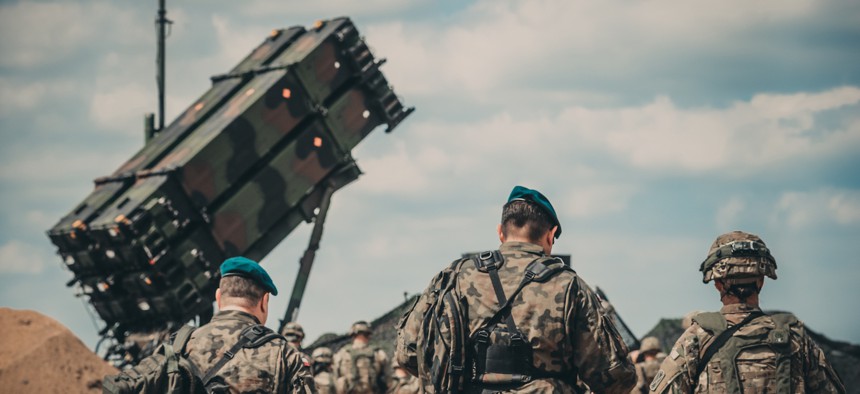
Service members from the U.S. Army and the Polish Land Forces walk to the site of the new Patriot missile system for a verbal demonstration of its operation and capabilities near Drawsko Pomorskie, Poland, June 4, 2018. Michigan Army National Guard photo by Spc. Aaron Good/Released
Adding Sensors Saves Ammo, Army Network Testers Find
In a Thursday test, Sentinel radars helped air-warfare operators down simulated missiles with fewer interceptors.
The U.S. Army used a pair of short-range Sentinel radars to cue Patriot missiles and shoot down target drones on Thursday, a key test of its efforts to link more weapons, sensors, and gear in a seamless command-and-control web.
Operators in a battalion Engagement Operations Center at White Sands, N.M., used Northrop Grumman’s Integrated Battle Command System, or IBCS — the linchpin of the Army’s next-generation land-warfare network — to overcome “enemy” jamming and direct PAC-3 missiles to intercept simulated cruise missiles, service officials said.
Integrating a Patriot radar and missile battery with a Sentinel radar may not sound very important. But the additional sensors gave operators precious extra minutes to plan their defense, and ultimately to down their targets with just one interceptor missile apiece, half the normal number used in an engagement, officials said.
The demonstration also showed the Army is on track in its broader effort to link together more weapons and more sensors in order to take out any target with anything on the battlefield, as opposed to tasking one weapon with one target and then struggling to adapt when there’s a miss. “Now imagine being able to take that with more sensors, more joint interceptors and with a joint command and control and now you have yourself the joint kill web,” said Lt. Gen. Dan Karbler, commander of the U.S. Army Space and Missile Defense Command.
The more sensors that are on the network, such as Sentinel, the more options available to take out the threat. Eventually, these sorts of sensor to weapon networks will fit into a much larger web that expands across the services and across land, air, sea, space and cyberspace, a vision dubbed Joint All-Domain Command and Control. “It doesn’t matter who owns the sensor… the ultimate vision, and we aren’t there yet, is it doesn’t even have to be an air defense sensor, as we integrate sensors into this network,” said Gen. Murray, the commander of Army Futures Command.




